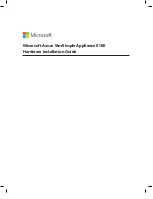
Converting and Porting Your Existing Applications into Web Applications
BEA WebLogic Server 7.0 Upgrade Guide
2-15
Porting a Simple Servlet from WebLogic Server 5.1 to
WebLogic Server 7.0
The following procedure ports the simple Hello World Servlet that was provided with
WebLogic 5.1 Server to WebLogic Server 7.0.
1. In WebLogic Server 7.0, create the correct directory structure, as described in
Administration and Configuration
in
Programming WebLogic Server HTTP
Servlets
. This involves creating a root application directory, such as
C:\hello
, as
well as a
C:\hello\WEB-INF
directory and a
C:\hello\WEB-INF\classes
directory. Place the
HelloWorld.Servlet.java
file inside the
C:\hello\WEB-INF\classes
directory.
2. Create a
web.xml
file for this servlet. If you have converted your
weblogic.properties
file, a
web.xml
file has already been created for you. If
you registered HelloWorldServlet in your
weblogic.properties
file before
you converted it, the servlet will be properly configured in your new
web.xml
file. An XML file can be created with any text editor. The following is an
example of a basic
web.xml
file that could be used with the HelloWorldServlet.
<!DOCTYPE web-app (View Source for full doctype...)>
- <web-app>
- <servlet>
<servlet-name>HelloWorldServlet</servlet-name>
<servlet-class>examples.servlets.HelloWorldServlet</servlet-cla
ss>
</servlet>
- <servlet-mapping>
<servlet-name>HelloWorldServlet</servlet-name>
<url-pattern>/hello/*</url-pattern>
</servlet-mapping>
</web-app>
For more information on
web.xml
files, see
Writing Web Application
Deployment Descriptors
in
Assembling and Configuring Web Applications
. A
weblogic.xml
file is not necessary with such a simple, stand-alone servlet as
HelloWorld.
For more information on
weblogic.xml
files, see
Writing the
WebLogic-Specific Deployment Descriptor
in
Assembling and Configuring Web
Applications
.
















































